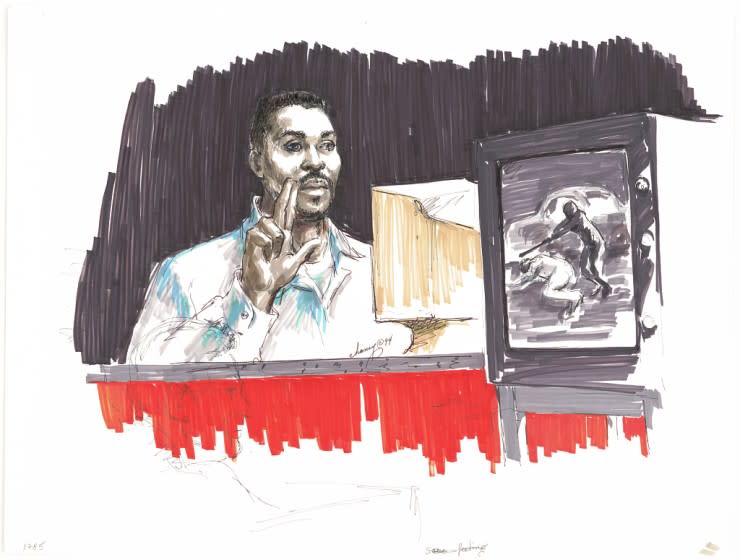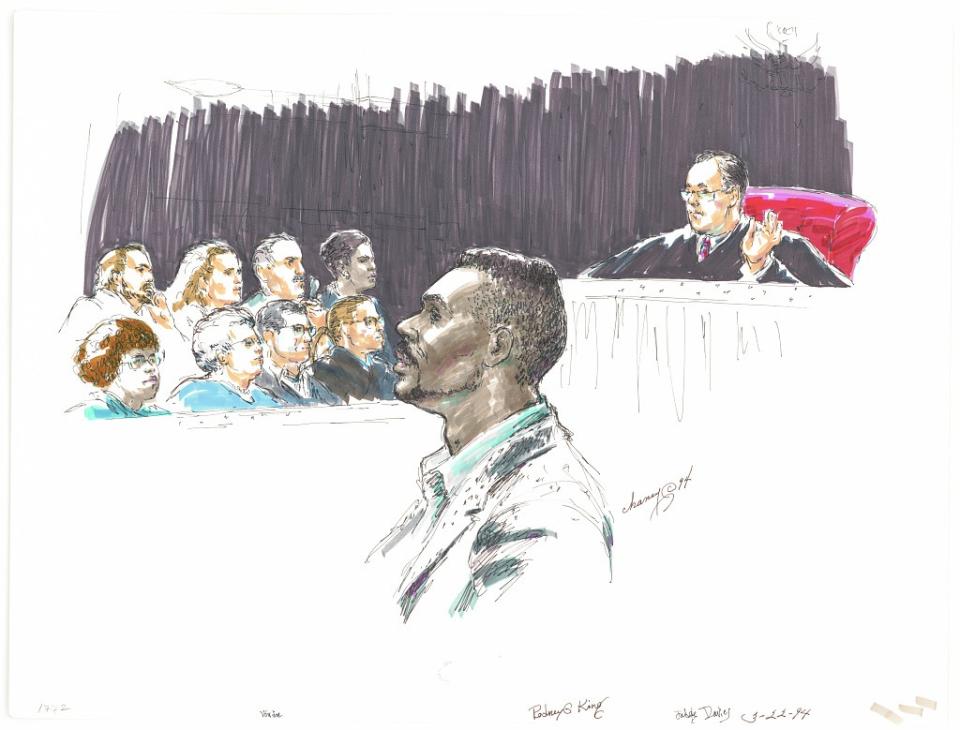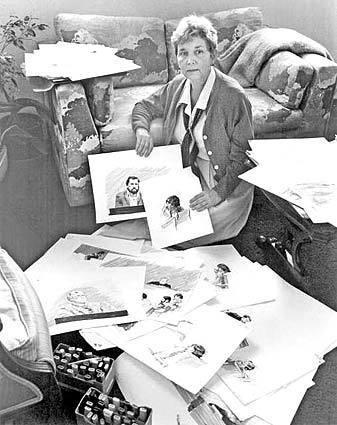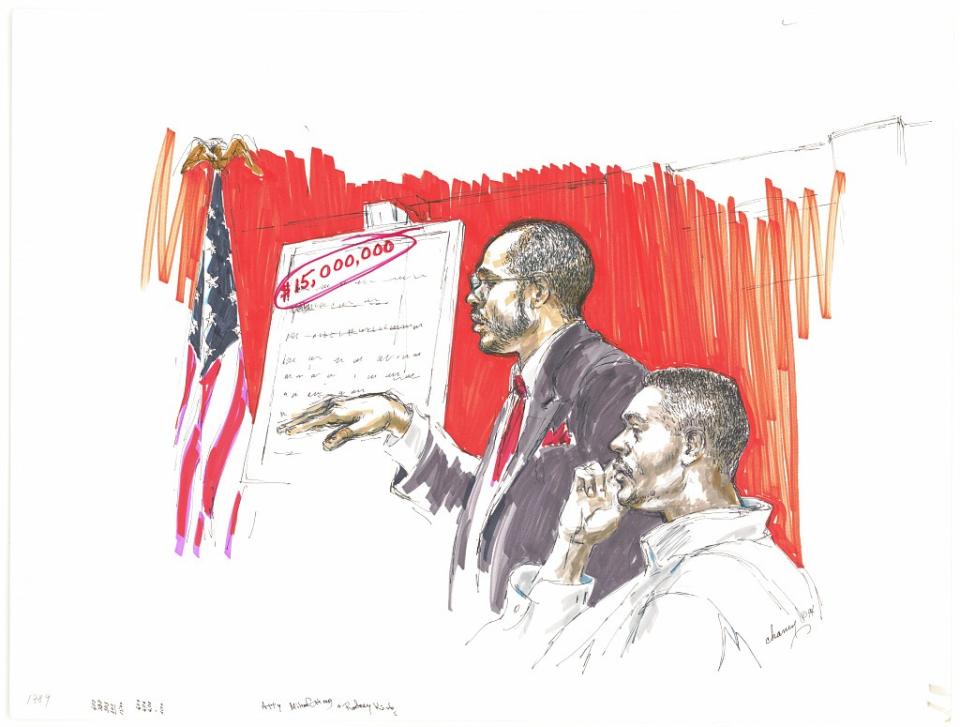Rodney King trials were captured in courtroom art. Library of Congress is preserving it

- Oops!Something went wrong.Please try again later.
During her 15-year career as a courtroom artist, Mary Chaney created vivid and delicate glimpses of high-profile Los Angeles cases including the O.J. Simpson civil trial, the Richard Ramirez “Night Stalker” trial and the trial of Hollywood madam Heidi Fleiss. After Rodney King’s vicious beating by four L.A. police officers 30 years ago, Chaney’s marker and ink sketches documented King’s criminal and civil trials between 1992 and 1994, relaying the energy and emotion of the courtroom to the public.
Chaney’s collection of 269 sketches relating to King — including the 1993 sentencing of officers Laurence Powell and Stacey Koon on federal civil rights charges and the 1994 civil trial where a jury awarded King $3.8 million in damages — has been acquired by the Library of Congress.
It’s the latest addition to the Library’s Prints and Photographs division, which now has about 12,500 courtroom drawings from late artists Howard Brodie and Joseph Papin, and those still working today Marilyn Church and Bill Robles, among others who have documented court cases from 1964 to present day. Chaney, who died in 2005, is the first California-based, female courtroom artist in the Library of Congress' collection.
Courtroom drawing took off in the 1930s after sensational news coverage in the Charles Lindbergh baby kidnapping trial prompted the American Bar Assn. to recommend prohibiting cameras. Though few courtroom artists are working today, they’re traditionally hired by news media to cover federal and Supreme Court trials where photographic and television cameras are barred.

After Chaney’s death, her daughter Lark Ireland Snouffer began cataloging her mother’s work, creating a database of nearly 2,000 court sketches. Although the bulk of Chaney’s art remains with family, some pieces are scattered across the U.S. and with international buyers. Chaney’s drawings from the 1990s El Monte sweatshop case is included in the Smithsonian Institution’s National Museum of American History.
“This particular collection, the Rodney King, is so important and so historical,” Snouffer said. “I thought it really should be shared somewhere.”
Snouffer first reached out to the Library of Congress in 2018, but the library’s curator of popular and applied graphic art, Sara Duke, struggled to convince the organization to purchase the collection until last fall.
The deaths of Breonna Taylor, a Black woman shot to death by Louisville, Ky., police in her apartment and George Floyd, the Black man whose cruel killing at the hands of police led to a global uprising, added a layer of urgency to the King acquisition. Their deaths “made it clear that this was an issue of importance, not just to African Americans but to all Americans,” Duke said.
“Police brutality has existed for generations, but the beating of Rodney King was the first one I believe to be recorded and disseminated,” Duke said.
A firm specializing in modern, contemporary and emerging art, Jacqueline Silverman & Associates, appraised Chaney’s full collection of King original sketches for $100,000. The artwork also was appraised in tiers, and the library ultimately purchased the two top tiers, 129 sketches. The family donated the remaining 140. (Duke did not disclose the amount paid by the library but said it was less than the full appraisal.)
“I wanted to keep the collection together and that just seemed like the best way to do it,” Snouffer said.
Chaney was “heartbroken” working the King trials, said daughter Annie Wren Cook, who spoke with Chaney daily during the King trials. “She had a strong sense of fairness and justice. The fact that the policemen who were involved in the beating were paid public servants and this is what they did, outraged her,” Cook said.
Born in L.A. in 1927, Chaney graduated from Otis College of Art and Design, Chouinard Art Institute and Loyola Marymount University. She worked as a commercial illustrator before starting her freelance career in the courtroom in 1985, and she provided sketches for news outlets including ABC, NBC and CNN.

Chaney was a lifelong artist who drew everywhere, Snouffer and Cook said, often heading downtown to sketch people in their daily lives. As a courtroom artist, “she was able to separate herself emotionally from the horrific things that she was hearing in the courtroom,” Cook said. “That’s how she was able to capture these moments, focusing on it purely as a piece of art.”
She thought of the 1992 L.A. riots, which began after a jury in Ventura County acquitted four LAPD officers of beating King, as “another terrible tragedy,” Cook said. “She said, ‘as long as Black and brown people are targeted by the police, this is going to happen over and over again.’”
Courtroom sketches were a form of social justice for Chaney.
During King’s trials, “she wanted to make sure that people understood … he was a human being, and he was a man with dignity, and he wasn’t just some thug off the street who deserved what he got,” Cook said.
The collection will be processed by archivists before it will eventually be made accessible to the public. Other courtroom sketches at the Library of Congress have aided researchers working on documentaries including the 2020 documentary “Yusuf Hawkins: Storm Over Brooklyn” and the 2020 Netflix docuseries “Trial by Media.”
Both Snouffer and Cook are thrilled that Chaney’s collection now lives at the library. “I hope people don’t forget these moments in history,” Cook said. “Because we’ve got a long ways to go.”

This story originally appeared in Los Angeles Times.

